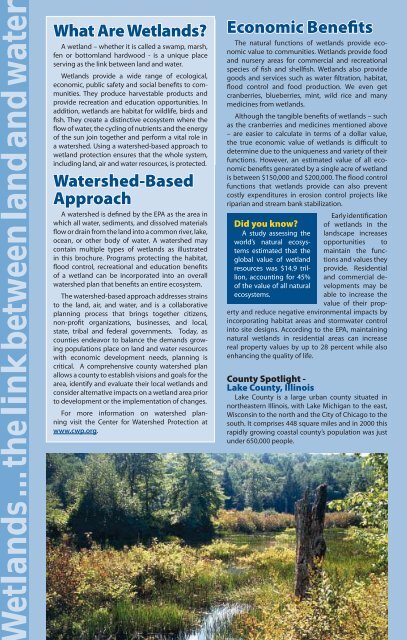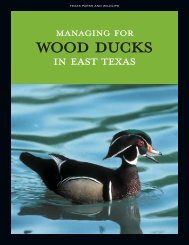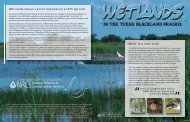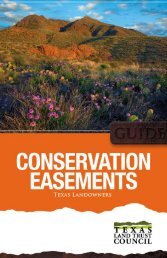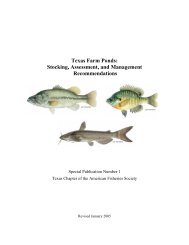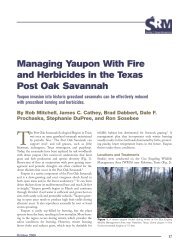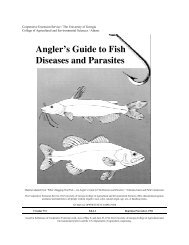Benefits of Wetlands - Trinity Waters
Benefits of Wetlands - Trinity Waters
Benefits of Wetlands - Trinity Waters
- No tags were found...
Create successful ePaper yourself
Turn your PDF publications into a flip-book with our unique Google optimized e-Paper software.
etlands ... the link between land and waterWhat Are <strong>Wetlands</strong>?A wetland – whether it is called a swamp, marsh,fen or bottomland hardwood - is a unique placeserving as the link between land and water.<strong>Wetlands</strong> provide a wide range <strong>of</strong> ecological,economic, public safety and social benefits to communities.They produce harvestable products andprovide recreation and education opportunities. Inaddition, wetlands are habitat for wildlife, birds andfish. They create a distinctive ecosystem where theflow <strong>of</strong> water, the cycling <strong>of</strong> nutrients and the energy<strong>of</strong> the sun join together and perform a vital role ina watershed. Using a watershed-based approach towetland protection ensures that the whole system,including land, air and water resources, is protected.<strong>Waters</strong>hed-BasedApproachA watershed is defined by the EPA as the area inwhich all water, sediments, and dissolved materialsflow or drain from the land into a common river, lake,ocean, or other body <strong>of</strong> water. A watershed maycontain multiple types <strong>of</strong> wetlands as illustratedin this brochure. Programs protecting the habitat,flood control, recreational and education benefits<strong>of</strong> a wetland can be incorporated into an overallwatershed plan that benefits an entire ecosystem.The watershed-based approach addresses strainsto the land, air, and water, and is a collaborativeplanning process that brings together citizens,non-pr<strong>of</strong>it organizations, businesses, and local,state, tribal and federal governments. Today, ascounties endeavor to balance the demands growingpopulations place on land and water resourceswith economic development needs, planning iscritical. A comprehensive county watershed planallows a county to establish visions and goals for thearea, identify and evaluate their local wetlands andconsider alternative impacts on a wetland area priorto development or the implementation <strong>of</strong> changes.For more information on watershed planningvisit the Center for <strong>Waters</strong>hed Protection atwww.cwp.org.Economic <strong>Benefits</strong>The natural functions <strong>of</strong> wetlands provide economicvalue to communities. <strong>Wetlands</strong> provide foodand nursery areas for commercial and recreationalspecies <strong>of</strong> fish and shellfish. <strong>Wetlands</strong> also providegoods and services such as water filtration, habitat,flood control and food production. We even getcranberries, blueberries, mint, wild rice and manymedicines from wetlands.Although the tangible benefits <strong>of</strong> wetlands – suchas the cranberries and medicines mentioned above– are easier to calculate in terms <strong>of</strong> a dollar value,the true economic value <strong>of</strong> wetlands is difficult todetermine due to the uniqueness and variety <strong>of</strong> theirfunctions. However, an estimated value <strong>of</strong> all economicbenefits generated by a single acre <strong>of</strong> wetlandis between $150,000 and $200,000. The flood controlfunctions that wetlands provide can also preventcostly expenditures in erosion control projects likeriparian and stream bank stabilization.Did you know?A study assessing theworld’s natural ecosystemsestimated that theglobal value <strong>of</strong> wetlandresources was $14.9 trillion,accounting for 45%<strong>of</strong> the value <strong>of</strong> all naturalecosystems.Early identification<strong>of</strong> wetlands in thelandscape increasesopportunities tomaintain the functionsand values theyprovide. Residentialand commercial developmentsmay beable to increase thevalue <strong>of</strong> their propertyand reduce negative environmental impacts byincorporating habitat areas and stormwater controlinto site designs. According to the EPA, maintainingnatural wetlands in residential areas can increasereal property values by up to 28 percent while alsoenhancing the quality <strong>of</strong> life.County Spotlight -Lake County, IllinoisLake County is a large urban county situated innortheastern Illinois, with Lake Michigan to the east,Wisconsin to the north and the City <strong>of</strong> Chicago to thesouth. It comprises 448 square miles and in 2000 thisrapidly growing coastal county’s population was justunder 650,000 people.2


